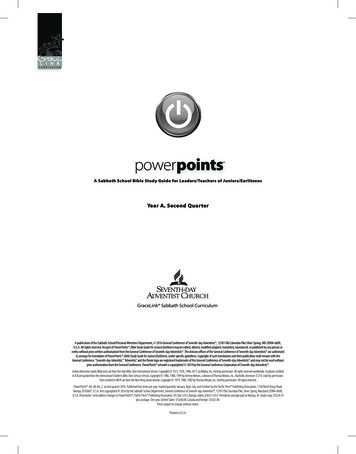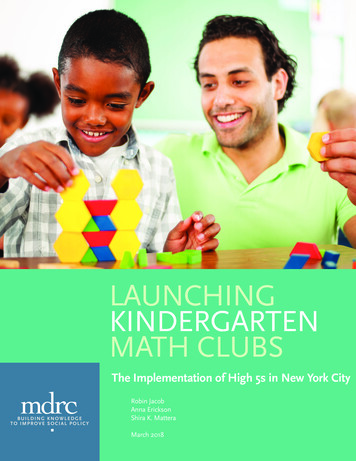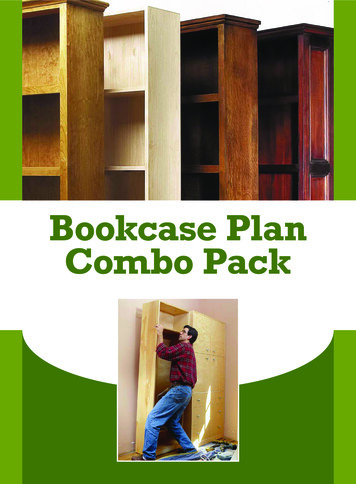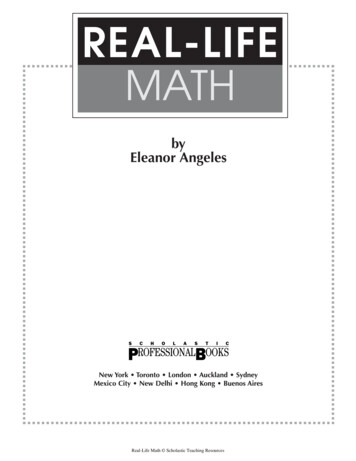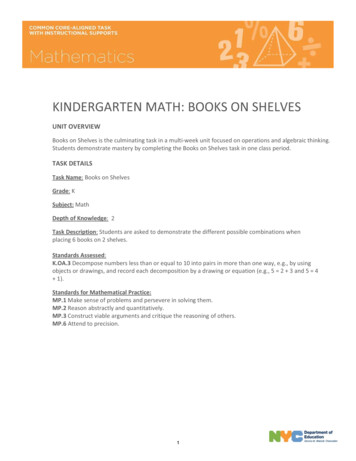
Transcription
KINDERGARTEN MATH: BOOKS ON SHELVESUNIT OVERVIEWBooks on Shelves is the culminating task in a multi-week unit focused on operations and algebraic thinking.Students demonstrate mastery by completing the Books on Shelves task in one class period.TASK DETAILSTask Name: Books on ShelvesGrade: KSubject: MathDepth of Knowledge: 2Task Description: Students are asked to demonstrate the different possible combinations whenplacing 6 books on 2 shelves.Standards Assessed:K.OA.3 Decompose numbers less than or equal to 10 into pairs in more than one way, e.g., by usingobjects or drawings, and record each decomposition by a drawing or equation (e.g., 5 2 3 and 5 4 1).Standards for Mathematical Practice:MP.1 Make sense of problems and persevere in solving them.MP.2 Reason abstractly and quantitatively.MP.3 Construct viable arguments and critique the reasoning of others.MP.6 Attend to precision.1
TABLE OF CONTENTSThe task and instructional supports in the following pages are designed to help educators understandand implement tasks that are embedded in Common Core-aligned curricula. While the focus for the2011-2012 Instructional Expectations is on engaging students in Common Core-aligned culminatingtasks, it is imperative that the tasks are embedded in units of study that are also aligned to the newstandards. Rather than asking teachers to introduce a task into the semester without context, this workis intended to encourage analysis of student and teacher work to understand what alignment looks like.We have learned through the 2010-2011 Common Core pilots that beginning with rigorous assessmentsdrives significant shifts in curriculum and pedagogy. Universal Design for Learning (UDL) support isincluded to ensure multiple entry points for all learners, including students with disabilities and Englishlanguage learners.PERFORMANCE TASK: BOOKS ON SHELVES . .3UNIVERSAL DESIGN FOR LEARNING (UDL) PRINCIPLES 5RUBRIC . 7ANNOTATED STUDENT WORK 13INSTRUCTIONAL SUPPORTS .36UNIT OUTLINE 37INITIAL ASSESSMENT: GOLDFISH .41FORMATIVE ASSESSMENT: PRETTY TULIPS .43GAMES AND ACTIVITIES . 44SUPPORTS FOR ENGLISH LANGUAGE LEARNERS . . 61SUPPORTS FOR STUDENTS WITH DISABILITIES 63Acknowledgements: The unit outline was developed by Kerry Cunningham (CFN 208) with input from CurriculumDesigners Alignment Review Team. The tasks were developed by the schools in the 2010-2011 NYC DOEElementary School Performance Based Assessment Pilot, in collaboration Exemplars, Inc. and the Center forAssessment.2
J &;'W ' ; X Y ?99 9 Y;PZ; ;' 9'X ; 3
NameBooks on S helvesMiguel has two shelves. Miguel has six books. Miguel wants to put bookson the two shelves. How many different ways can Miguel put books onthe two shelves? Show and tell how you know.4
J &;'W ' ; X Y ?99 9 Y;PZ; U JZ;' P &; JW 9' P; ' J W U&P 'J J P; 5
Books on Shelves – Math Grade KCommon Core Learning Standards/Universal Design for LearningThe goal of using Common Core Learning Standards (CCLS) is to provide the highest academicstandards to all of our students. Universal Design for Learning (UDL) is a set of principles thatprovides teachers with a structure to develop their instruction to meet the needs of a diversity oflearners. UDL is a research-based framework that suggests each student learns in a unique manner.A one-size-fits-all approach is not effective to meet the diverse range of learners in our schools. Bycreating options for how instruction is presented, how students express their ideas, and howteachers can engage students in their learning, instruction can be customized and adjusted to meetindividual student needs. In this manner, we can support our students to succeed in the CCLS.Below are some ideas of how this Common Core Task is aligned with the three principles of UDL;providing options in representation, action/expression, and engagement. As UDL calls for multipleoptions, the possible list is endless. Please use this as a starting point. Think about your own groupof students and assess whether these are options you can use.REPRESENTATION: The “what” of learning. How does the task present information and content indifferent ways? How do students gather facts and categorize what they see, hear, and read? Howare they identifying letters, words, or an author's style?In this task, teachers can 9 Highlight or emphasize key elements in text, graphics, and diagrams by providing access toconcrete or virtual manipulatives, such as pictures or models of book on shelves.ACTION/EXPRESSION: The “how” of learning. How does the task differentiate the ways thatstudents can express what they know? How do they plan and perform tasks? How do studentsorganize and express their ideas?In this task, teachers can 9 Provide graphic organizers and templates for data collection and organizing information tohelp students organize their thoughts and establish relationships between ideas. Graphic organizerscan be paper/pencil or found on-line.ENGAGEMENT: The “why” of learning. How does the task stimulate interest and motivation forlearning? How do students get engaged? How are they challenged, excited, or interested?In this task, teachers can 9 Provide feedback that is frequent, timely, and specific by helping students see what they did welland why, see their errors and learn how to correct them by providing explicit and informativefeedback when assessing student work, making feedback a part of the learning process.Visit /default.htm to learn more information about UDL.6
KINDERGARTEN MATH:BOOKS ON SHELVESRUBRICThe following section contains two rubrics that were used to score student work: a content rubric and aprocess rubric. The content rubric describes student performance according to the content standards inthe CCLS. The process rubric describes student performance according to the National Council ofTeachers of Mathematics (NCTM) process standards. Students’ were given a score based on theirachievement on the CCLS content rubric and the process rubric. Given that the process rubric is not inthe language of the Common Core’s Mathematical Practices, we have also included a document thatNCTM has posted regarding the relationship between the NCTM process standards and the Standardsfor Mathematical Practice.7
CCSS Mathematics Content Standards & Standards in Practice Grades K-1 Progress-Monitoring Focus: Addition & subtraction; Comparing & ordering numbers Math CCSSCriteria/ClustersCounting & Cardinality(K only)NoviceApprenticePractitionerExpert! " # % & ' () % ) ! Represents number ofobjects for written numerals,0-20K.CC-3Counts to find out how many;Determines greater than/lessthan of groups of objects (upto 20 if ordered; up to 10 ifrandom)K.CC- 4, 5Compares numbers between1 and 10 using writtennumeralsK.CC-6, 7) * 8
Operations & AlgebraicThinkingAnd, Number & Operations inBase TenMeasurement & Data %% & # & " . ) ! Represents, compares, &solves addition & subtractionusing strategies – counting,objects, drawings, etc. -to 10K.OA-1, 2-or to 20; with multipleaddends; using equal signand equations1. OA-1, 2, 6, 7, 8Composes/ decomposes andcompares numbers usingtens and onesK.OA-3; K.NBT-11.NBT- 2, 3Applies associative& commutative properties1.OA-3Minor computation flaws do notaffect outcome of a correctsolution) " Describes measurable attributes; compares measures of objectsK.MD-1, 2 % Measures to whole unit; compares 2 or 3 objects;. / classifies objects using more % than 1 attribute1.MD-1, 2 Measures & compareslengths indirectly1.MD-1Tells time to hour & half hourusing digital and analogclocks1.MD-39) * % , - , % ! % * ' %%
Exemplars Standards-Based Math Rubric*Problem SolvingNoviceNo strategy is chosen, or astrategy is chosen that will notlead to a solution.Little or no evidence of engagement in the task present.ApprenticeA partially correct strategy ischosen, or a correct strategyfor only solving part of thetask is chosen.Evidence of drawing on someprevious knowledge is present, showing some relevantengagement in the task.Reasoning and ProofCommunicationArguments are made with nomathematical basis.No correct reasoning nor justification for reasoning is present.Arguments are made with somemathematical basis.No awareness of audience orpurpose is communicated.orLittle or no communication ofan approach is evidentorEveryday, familiar language isused to communicate ideas.Some awareness of audienceor purpose is communicated,and may take place in the formSome correct reasoning or justifica- of paraphrasing of the task.tion for reasoning is present withortrial and error, or unsystematicSome communication of antrying of several cases.approach is evident throughverbal/written accounts andexplanations, use of diagramsor objects, writing, and usingmathematical symbols.orSome formal math languageis used, and examples are provided to communicate ideas.ConnectionsRepresentationNo connections aremade.No attempt is made toconstruct mathematicalrepresentations.Some attempt to relate the task to othersubjects or to owninterests and experiences is made.An attempt is made toconstruct mathematicalrepresentations to record and communicateproblem solving. 2011, Exemplars*Based on revised NCTM standards.10
Exemplars Standards-Based Math Rubric (Cont.)*Problem SolvingPractitionerA correct strategy is chosenbased on mathematical situation in the task.Planning or monitoring ofstrategy is evident.Evidence of solidifying priorknowledge and applying it tothe problem solving situationis present.Reasoning and ProofCommunicationArguments are constructed withadequate mathematical basis.A systematic approach and/orjustification of correct reasoning ispresent. This may lead to. clarification of the task. exploration of mathematicalphenomenon. noting patterns, structures andregularities.Note: The practitioner mustachieve a correct answer.ExpertWork at thislevel isexceedinggrade-levelexpectationsA sense of audience or purpose is communicated.and/orCommunication of an approach is evident through amethodical, organized, coherent sequenced and labeledresponse.RepresentationMathematical conAppropriate and acnections or observa- curate mathematicaltions are recognized. representations areconstructed and refinedto solve problems orportray solutions.Formal math language is usedthroughout the solution toshare and clarify ideas.An efficient strategy is chosen and progress towards asolution is evaluated.Deductive arguments are used to A sense of audience and purjustify decisions and may resultpose is communicated.in formal proofs.and/orAdjustments in strategy, ifnecessary, are made alongthe way, and / or alternativestrategies are considered.Evidence is used to justify andsupport decisions made andconclusions reached. This maylead to. testing and accepting or rejecting of a hypothesis or conjecture. explanation of phenomenon. generalizing and extendingthe solution to other cases.Evidence of analyzing thesituation in mathematicalterms, and extending priorknowledge is present.ConnectionsCommunication at the Practitioner level is achieved, andcommunication of argumentis supported by mathematical properties.Mathematicalconnections orobservations areused to extend thesolution.Abstract or symbolicmathematical representations are constructed to analyzerelationships, extendthinking, and clarifyor interpret phenomenon.Precise math language andsymbolic notation are usedto consolidate math thinkingand to communicate ideas.Note: The expert mustachieve a correct answer. 2011, Exemplars*Based on revised NCTM standards.11
National Council of Teachers of Mathematics (NCTM) Process Standards and theCommon Core State Standards for MathematicsFrom NCTM Action on the Common Core State Standards for Mathematicsby NCTM President J. Michael Shaughnessy“The preeminent message in both the NCTM Principles and Standards for School Mathematics(2000) and CCSSM is the importance of nurturing mathematical thinking and reasoningprocesses in our students. No bulleted list of specific content standards will hold together as acoherent, meaningful whole, or make any significant contribution to our students’ growth inmathematics, without interweaving mathematical “practices.” Mathematics curricula mustshow students the power of reasoning and sense making as they explore mathematicalstructures, of communication as they construct viable arguments, and of multiplerepresentations as they engage in mathematical modeling. The close connections between theNCTM Process Standards and the CCSSM Standards for Mathematical Practice are representedin the chart below.The upcoming NCTM publication, Making it Happen, will provide a deeper analysis of theconnections between the NCTM Process Standards and detail the potential of the existingNCTM resources to interpret and implement CCSSM.”12
KINDERGARTEN MATH: BOOKS ON SHELVESANNOTATED STUDENT WORKThis section contains annotated student work at a range of score points, student summaries, andimplications for instruction for each performance level. The annotated student work and studentsummaries demonstrate performance at different levels and show examples of student understandingsand misunderstandings of the task that can be used with the implications for instruction to understandhow to move students to the next performance level.13
Kindergarten Math: Books on ShelvesAnnotated Student WorkThis student is an Expert according to boththe Exemplars Rubric and the CCSS ContentStandards Rubric, (both included in thesupporting materials).The student is able tomake sense of theproblem andpersevere in finding apathway to solving it.The student uses adiagram to show thefive possiblecombinations for sixbooks on two shelves.The student states acorrect answer, “5ways.”The studentcandecomposenumbers lessthan or equalto 10 in pairsin more thanone way, andrecord eachdecomposition by adrawing orequation(K.OA 3).The student models withmathematics by creating a diagramand a key, and a table with correctlabels and data. The student usesboth representations to clarify andsupport the answer.The studentapplies theprecisemathematicallanguagediagram, key,fair share,equal, evennumber,combinations, table,pattern, tohelpconstructviablearguments.The studentconstructs a newargument, “If thebooks can go ononly one shelf youcan have twomorecombinationszero and six, sixand zero.”14
Kindergarten Math: Books on ShelvesAnnotated Student WorkThe student justifiesthe reasonablenessof her/his conclusionsby verifying theanswer using a newstrategy of a tableand states, “TellMiguel it is five wayscuz I know it is.” Thestudent searches forregularity anddiscerns a pattern,“Look the books goup by 1 here andbooks go down byone here. That is apattern.”15
Kindergarten Math: Books on ShelvesAnnotated Student WorkExpert – Student 1 SummaryAchievement Level: Student 1 is an Expert according to both the Exemplars Process Rubric and theCCSS Content Standards Rubric, (both of which are included in the supporting materials). The tablebelow provides a rationale for the student’s performance level in each of the criteria identified in theExemplars Process Rubric.Criteria andPerformance LevelProblem SolvingExpertRationaleThe student’s strategy of using a diagram to show the totalcombinations for placing six books on two shelves works to solve theproblem. The student shows five correct combinations and correctlystates, “5 ways.” The student uses an alternative strategy of a tableto support her/his answer.Reasoning and ProofExpertThe student shows correct reasoning of the underlying mathematicalconcepts of combinations to six, the commutative property, andunderstanding that 0 6 6 and 6 0 6 can not be considered aspossible combinations for the problem. The student verifies her/hissolution by solving the problem a second way.CommunicationExpertThe student correctly uses the mathematical terms-diagram, key, fairshare, equal, even number, combinations, table, pattern.ConnectionsExpertThe student makes the Practitioner mathematically relevantconnections, “This is a fair share of books for the two shelves,” “Thatmeans equal,” “Six books means even number,” “If the books can goon only one shelf you can have two more ways-zero and six, six andzero,” and, “Look the books go up by one here and books go down byone here, that is a pattern.” The student makes the Expertconnection by using a table to solve the problem a second way andlinking the two strategies together to verify that her/his solution iscorrect. The student states, I did five ways here and here. Tell Miguelit is five ways cuz I know it is.”RepresentationExpertThe student’s diagrams are appropriate to the problem and accurate.The student’s key and the scribing correctly define the books andshelves. The student’s table is appropriate to the problem andaccurate. Each column is correctly labeled and all entered data iscorrect. The student uses her/his table to clarify and support theanswer.16
Kindergarten Math: Books on ShelvesAnnotated Student WorkInstructional Implications: Books on Shelves KAchievement Level: ExpertNote: Student work identified at this level is exceeding grade-level expectationsThe following is a list of instructional implications that you may want to considerfor students performing at the Expert level. In addition, you may want to consultthe suggestions for the Practitioner level: Find combinations for numbers greater than ten Investigate and prove generalization-total combinations is one less than sumbeing found Investigate and prove generalization-if zero can be considered the totalcombinations is one more than sum Solve problem more than one way to verify that answer is correct Relate problem to a similar one completed and discuss how they aremathematically similar Discover and discuss why an even number has a fair share/equal combinationbut an odd number does not17
Kindergarten Math: Books on ShelvesAnnotated Student WorkThis student is a Practitioner according toboth the Exemplars Rubric and the CCSSContent Standards Rubric, (both included inthe supporting materials).The student applies theprecise mathematicallanguage-diagram, key,number sentences, equal,to help construct her/hisviable argument.The student candecomposenumbers less thanor equal to 10 inpairs in more thanone way, andrecord eachdecomposition by adrawing orequation (K.OA 3).The student is ableto make sense ofthe problem andpersevere infinding a pathwayto solving it. Thestudent shows thefive possiblecombinations forsix books on twoshelves andcorrectly states, “Igot five ways.”The studentmodelsmathematicsby creating adiagram thatis appropriateand accurate.A key andscribingcorrectlydefines thebooks andshelves.The student reasonsquantitatively by makingthe connection, “You can’tturn three and threearound because they arethe same number.”18
Kindergarten Math: Books on ShelvesAnnotated Student WorkPractitioner – Student 1 SummaryAchievement Level: Student 1 is a Practitioner according to both the Exemplars Process Rubric and theCCSS Content Standards Rubric, (both of which are included in the supporting materials). The tablebelow provides a rationale for the student’s performance level in each of the criteria identified in theExemplars Process Rubric.Criteria andPerformance LevelProblem SolvingPractitionerReasoning and ProofPractitionerRationaleThe student’s strategy of using a diagram and number sentences toshow the total combinations for placing six books on two shelvesworks to solve the problem. The student shows five correctcombinations and correctly states, “I got five ways.”The student shows correct reasoning of the underlying mathematicalconcepts of combinations to six, the commutative property, andunderstanding that 0 6 6 and 6 0 6 can not be considered aspossible combinations for the problem.CommunicationPractitionerThe student correctly uses the mathematical terms-diagram, key,number sentences, equal.ConnectionsPractitionerThe student makes the mathematically relevant connection, “Youcan’t turn three and three around because they are the samenumber.” The student’s statements, “all ჱ is 6,” and, “The twosides has to equal six,” are not considered connections as theyrepresent the reasoning a student must understand to solve theproblem.RepresentationPractitionerThe student’s diagram is appropriate to the problem and accurate.The student’s key and the scribing correctly defines the books andshelves.19
Kindergarten Math: Books on ShelvesAnnotated Student WorkThis student is a Practitioner according to theExemplars Rubric and an Expert according tothe CCSS Content Standards Rubric, (bothincluded in the supporting materials).Exemplars Rubric: PractitionerCCSS Content Rubric: ExpertThe student isable to makesense of theproblem andpersevere insolving it. Thestudent showsthe five possiblecombinations forsix books on twoshelves, andcorrectly states,“Miguel has fiveways to do thebooks.”The student can decomposenumbers less than or equal to10 in pairs in more than oneway, and record eachdecomposition by a drawingor equation (K.OA 3).The student applies the precisemathematical language-table,key, to help construct her/hisviable argument.The studentreasons abstractlyand quantitativelyby making theconnection, “3books and 3books is the sameon shelf one andshelf two andsearches forregularity bystating, “I went 1book, 2 book, 3book, 4 book, 5book, so I don’tmiss any ways.The student models with mathematics byusing a table with a key to define the shelvesand books. The student reflects andimproves the model/table by keeping thekey for shelves but uses numbers in place ofthe books and states, “I did it with numbers.It is faster this way.”20
Kindergarten Math: Books on ShelvesAnnotated Student WorkPractitioner/Expert – Student 2 SummaryAchievement Level: Student 2 is a Practitioner according to the Exemplars Process Rubric and anExpert according to the CCSS Content Standards Rubric, (both of which are included in the supportingmaterials). The table below provides a rationale for the student’s performance level in each of thecriteria identified in the Exemplars Process Rubric.Criteria andPerformance LevelProblem SolvingPractitionerRationaleThe student’s strategy of using a table to show the totalcombinations for placing six books on two shelves works to solve theproblem. The student shows five correct combinations and states,“5,” which is also correct. The scribing also correctly states, “Miguelhas five ways to do the books. One plus five, two plus four, three plusthree, four plus two, five plus one.”Reasoning and ProofPractitionerThe student shows correct reasoning of the underlying mathematicalconcepts of combinations to six, the commutative property, andunderstanding that 0 6 6 and 6 0 6 can not be considered aspossible combinations for the problem.CommunicationPractitionerThe student correctly uses the mathematical terms-table, key.ConnectionsPractitionerThe student makes the mathematically relevant connection of usinga different form of a table to show the five correct combinations. Thestudent states, “I did it with numbers. It is faster this way.” Thestudent makes the mathematically relevant observation, “Threebooks and three books is the same on shelf one and shelf 2.”RepresentationPractitionerThe student’s first table is appropriate to the problem and accurate.The key, column labels, and scribing correctly identify the books andshelves.21
Kindergarten Math: Books on ShelvesAnnotated Student WorkThis student is a Practitioner according toboth the Exemplars Rubric and the CCSSContent Standards Rubric, (both included inthe supporting materials).The student is able tomake sense of theproblem andpersevere in finding apathway to solving it.The student uses adiagram and numbersentences to showthe five possiblecombinations for sixbooks on two shelves.The student states acorrect answer, “5.”The studentapplies theprecisemathematical languagediagram,key, to helpconstructher/hisviableargument.The student modelswith mathematics.The diagram isappropriate andaccurate. A key andscribing define theshelves and books.The student can decompose numbersless than or equal to 10 in pairs inmore than one way, and record eachdecomposition by a drawing orequation (K.OA 3).22The student reasonsabstractly and quantitativelyby making the connection,“three and three is the onlyone with the same numberbooks on a shelf-three.”
Kindergarten Math: Books on ShelvesAnnotated Student WorkPractitioner – Student 3 SummaryAchievement Level: Student 3 is a Practitioner according to both the Exemplars Process Rubric and theCCSS Content Standards Rubric, (both of which are included in the supporting materials). The tablebelow provides a rationale for the student’s performance level in each of the criteria identified in theExemplars Process Rubric.Criteria andPerformance LevelProblem SolvingPractitionerRationaleThe student’s strategy of using a diagram and number sentences toshow the total combinations for placing six books on two shelvesworks to solve the problem. The student shows five correctcombinations and correctly states, “5.” The student also correctlystates, “I used my fingers. I did one and five, two and four, three andthree, four and two, five and one.”Reasoning and ProofPractitionerThe student shows correct reasoning of the underlying mathematicalconcepts of combinations to six, the commutative property, andunderstanding that 0 6 6 and 6 0 6 can not be considered aspossible combinations for the problem.CommunicationPractitionerThe student correctly uses the mathematical terms-diagram, keyConnectionsPractitionerThe student makes the mathematically relevant connection, “six andsix is the only one with the same number of books on a shelf-three.”RepresentationPractitionerThe student’s diagram is appropriate to the problem and accurate.The student’s key and the scribing correctly label the books andshelves.23
Kindergarten Math: Books on ShelvesAnnotated Student WorkInstructional Implications: Books on Shelves KStudent Achievement Level: PractitionerThe following is a list of instructional implications that you may want to considerfor students performing at the Practitioner level. In addition, you may want toconsult the suggestions for the Novice and Apprentice levels: Include more writing of number sentences to support the possible combinationsfor any number up to ten in a student’s diagram, table, etc. Discuss and solve problems where zero would be used in a combination andwhen it would not be used Introduce the language term-commutative property Encourage student to make more than one mathematically relevant connectionabout her/his work Investigate where a combination is a fair share Introduce another strategy to solve the same problem-model, diagram/key,organized list, table24
Kindergarten Math: Books on ShelvesAnnotated Student WorkThis student is an Apprentice according toboth the Exemplars Rubric and the CCSSContent Standards Rubric, (both included inthe supporting materials).The student is able tomake sense of theproblem andpersevere in finding asolution pathway. Thestudent’s answer, “5,”is correct.The studentapplies theprecisemathematicallanguagediagram, key,to helpconstructher/his viableargument.The student can decomposenumbers less than or equalto 10 in pairs in more thanone way, and record eachdecomposition by a drawingor equation (K.OA 3).The student models withmathematics. The diagram isappropriate and accurate. Akey defines the books andshelves.The student doesnot reflect onher/his solution tomake connectionsto regularities,patterns,structures, ortrends.25
Kindergarten Math: Books on ShelvesAnnotated Student WorkApprentice - Student 1 SummaryAchievement Level: Student 1 is an Apprentice according to both the Exemplars Process Rubric andthe CCSS Content Standards Rubric, (both of which are included in the supporting materials). The tablebelow provides a rationale for the student’s performanc
KINDERGARTEN MATH: BOOKS ON SHELVES UNIT OVERVIEW Books on Shelves is the culminating task in a multi-week unit focused on operations and algebraic thinking. Students demonstrate mastery by completing the Books on Shelves task in one class period. TASK DETAILS Task Name: Books on Shelves Grad

